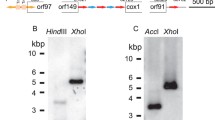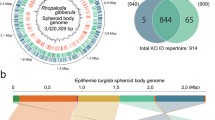Abstract
Reduction in size of flagellated chlorophytes occurred multiple times during evolution, providing the opportunity to study the consequences of cell reduction on genome architecture. Recent investigations on the chloroplast genomes of the tiny prasinophyceans Ostreococcus tauri (Mamiellales), Micromonas sp. RCC299 (Mamiellales), and Pycnococcus provasolii (Pseudocourfieldiales) highlighted their extreme compaction and reduced gene repertoires. Genome compaction is also exemplified by the Ostreococcus and Micromonas mitochondrial DNAs (mtDNAs) although they have retained almost all of the about 65 genes presumably present in the mitochondria of ancestral prasinophyceans. In this study, the mitochondrial genome of Pycnococcus was sequenced and compared to those of previously examined chlorophytes. Our results document the first case where cellular reduction of a free-living alga was accompanied by marked reduction in gene content of both the mitochondrial and chloroplast genomes. At 24,321 bp, the intronless Pycnococcus mitochondrial genome falls within the lower size range displayed by green algal mtDNAs. The 36 conserved genes, specifying two rRNAs with conventional structures, 16 tRNAs and 18 proteins, are all encoded on the same DNA strand and represent 88% of the genome. Besides a pronounced codon bias, the protein-coding genes feature a variant genetic code characterized by the use of TGA (normally a stop codon) to code for tryptophan, and the unprecedented use of TTA and TTG (normally leucine codons) as stop codons. We conclude that substantial reduction of the mitochondrial genome occurred in at least three independent chlorophyte lineages and that this process entailed a number of convergent changes in these lineages.





Similar content being viewed by others
References
Alfonzo JD, Blanc V, Estevez AM, Rubio MA, Simpson L (1999) C to U editing of the anticodon of imported mitochondrial tRNA(Trp) allows decoding of the UGA stop codon in Leishmania tarentolae. EMBO J 18:7056–7062
Altschul SF, Gish W, Miller W, Myers EW, Lipman DJ (1990) Basic local alignment search tool. J Mol Biol 215:403–410
Anderson S, Bankier AT, Barrell BG, de Bruijn MH, Coulson AR, Drouin J, Eperon IC, Nierlich DP, Roe BA, Sanger F, Schreier PH, Smith AJ, Staden R, Young IG (1981) Sequence and organization of the human mitochondrial genome. Nature 290:457–465
Asakawa S, Kumazawa Y, Araki T, Himeno H, Miura K, Watanabe K (1991) Strand-specific nucleotide composition bias in echinoderm and vertebrate mitochondrial genomes. J Mol Evol 32:511–520
Boer PH, Gray MW (1991) Short dispersed repeats localized in spacer regions in Chlamydomonas reinhardtii mitochondrial DNA. Curr Genet 19:309–312
Castresana J (2000) Selection of conserved blocks from multiple alignments for their use in phylogenetic analysis. Mol Biol Evol 17:540–552
de Koning AP, Keeling PJ (2006) The complete plastid genome sequence of the parasitic green alga Helicosporidium sp. is highly reduced and structured. BMC Biol 4:12
Denovan-Wright EM, Nedelcu AM, Lee RW (1998) Complete sequence of the mitochondrial DNA of Chlamydomonas eugametos. Plant Mol Biol 36:285–295
Derelle E, Ferraz C, Rombauts S, Rouze P, Worden AZ, Robbens S, Partensky F, Degroeve S, Echeynie S, Cooke R, Saeys Y, Wuyts J, Jabbari K, Bowler C, Panaud O, Piegu B, Ball SG, Ral JP, Bouget FY, Piganeau G, De Baets B, Picard A, Delseny M, Demaille J, Van de Peer Y, Moreau H (2006) Genome analysis of the smallest free-living eukaryote Ostreococcus tauri unveils many unique features. Proc Natl Acad Sci USA 103:11647–11652
Edgar RC (2004) MUSCLE: multiple sequence alignment with high accuracy and high throughput. Nucleic Acids Res 32:1792–1797
Fawley MW, Yun Y, Qin M (2000) Phylogenetic analyses of 18S rDNA sequences reveal a new coccoid lineage of the Prasinophyceae (Chlorophyta). J Phycol 36:387–393
Fernandez-Silva P, Enriquez JA, Montoya J (2003) Replication and transcription of mammalian mitochondrial DNA. Exp Physiol 88:41–56
Francino MP, Ochman H (1997) Strand asymmetries in DNA evolution. Trends Genet 13:240–245
Gregory TR (2001) Coincidence, coevolution, or causation? DNA content, cell size, and the C-value enigma. Biol Rev Camb Philos Soc 76:65–101
Grigoriev A (1998) Analyzing genomes with cumulative skew diagrams. Nucleic Acids Res 26:2286–2290
Guillou L, Eikrem W, Chrétiennot-Dinet M-J, Le Gall F, Massana R, Romari K, Pedrós-Alió C, Vaulot D (2004) Diversity of picoplanktonic prasinophytes assessed by direct nuclear SSU rDNA sequencing of environmental samples and novel isolates retrieved from oceanic and coastal marine ecosystems. Protist 155:193–214
Jobb G, von Haeseler A, Strimmer K (2004) TREEFINDER: a powerful graphical analysis environment for molecular phylogenetics. BMC Evol Biol 4:18
Keller MD, Selvin RC, Claus W, Guillard RRL (1987) Media for the culture of oceanic ultraphytoplankton. J Phycol 23:633–638
Knight RD, Freeland SJ, Landweber LF (2001) Rewiring the keyboard: evolvability of the genetic code. Nat Rev Genet 2:49–58
Kroymann J, Zetsche K (1998) The mitochondrial genome of Chlorogonium elongatum inferred from the complete sequence. J Mol Evol 47:431–440
Kück U, Jekosch K, Holzamer P (2000) DNA sequence analysis of the complete mitochondrial genome of the green alga Scenedesmus obliquus: evidence for UAG being a leucine and UCA being a non-sense codon. Gene 253:13–18
Kurtz S, Choudhuri JV, Ohlebusch E, Schleiermacher C, Stoye J, Giegerich R (2001) REPuter: the manifold applications of repeat analysis on a genomic scale. Nucleic Acids Res 29:4633–4642
Lewis LA, McCourt RM (2004) Green algae and the origin of land plants. Am J Bot 91:1535–1556
Lowe TM, Eddy SR (1997) tRNAscan-SE: a program for improved detection of transfer RNA genes in genomic sequence. Nucleic Acids Res 25:955–964
Massey SE, Garey JR (2007) A comparative genomics analysis of codon reassignments reveals a link with mitochondrial proteome size and a mechanism of genetic code change via suppressor tRNAs. J Mol Evol 64:399–410
Nedelcu AM, Lee RW, Lemieux C, Gray MW, Burger G (2000) The complete mitochondrial DNA sequence of Scenedesmus obliquus reflects an intermediate stage in the evolution of the green algal mitochondrial genome. Genome Res 10:819–831
Pombert JF, Otis C, Lemieux C, Turmel M (2004) The complete mitochondrial DNA sequence of the green alga Pseudendoclonium akinetum (Ulvophyceae) highlights distinctive evolutionary trends in the Chlorophyta and suggests a sister-group relationship between the Ulvophyceae and Chlorophyceae. Mol Biol Evol 21:922–935
Pombert JF, Lemieux C, Turmel M (2006) The complete chloroplast DNA sequence of the green alga Oltmannsiellopsis viridis reveals a distinctive quadripartite architecture in the chloroplast genome of early diverging ulvophytes. BMC Biol 4:3
Pröschold T, Leliaert F (2007) Systematics of the green algae: conflict of classic and modern approaches. In: Brodie J, Lewis J (eds) Unravelling the algae: the past, present, and future of algal systematics. CRC Press, Taylor & Francis, Boca Raton, pp 123–153
Rice P, Longden I, Bleasby A (2000) EMBOSS: the European molecular biology open software suite. Trends Genet 16:276–277
Robbens S, Derelle E, Ferraz C, Wuyts J, Moreau H, Van de Peer Y (2007) The complete chloroplast and mitochondrial DNA sequence of Ostreococcus tauri: organelle genomes of the smallest eukaryote are examples of compaction. Mol Biol Evol 24:956–968
Smith DR, Lee RW (2008) Mitochondrial genome of the colorless green alga Polytomella capuana: a linear molecule with an unprecedented GC content. Mol Biol Evol 25:487–496
Steinhauser S, Beckert S, Capesius I, Malek O, Knoop V (1999) Plant mitochondrial RNA editing. J Mol Evol 48:303–312
Tanaka M, Ozawa T (1994) Strand asymmetry in human mitochondrial DNA mutations. Genomics 22:327–335
Turmel M, Lemieux C, Burger G, Lang BF, Otis C, Plante I, Gray MW (1999a) The complete mitochondrial DNA sequences of Nephroselmis olivacea and Pedinomonas minor: two radically different evolutionary patterns within green algae. Plant Cell 11:1717–1729
Turmel M, Otis C, Lemieux C (1999b) The complete chloroplast DNA sequence of the green alga Nephroselmis olivacea: insights into the architecture of ancestral chloroplast genomes. Proc Natl Acad Sci USA 96:10248–10253
Turmel M, Otis C, Lemieux C (2007) An unexpectedly large and loosely packed mitochondrial genome in the charophycean green alga Chlorokybus atmophyticus. BMC Genom 8:137
Turmel M, Gagnon MC, O’Kelly CJ, Otis C, Lemieux C (2009a) The chloroplast genomes of the green algae Pyramimonas, Monomastix, and Pycnococcus shed new light on the evolutionary history of prasinophytes and the origin of the secondary chloroplasts of euglenids. Mol Biol Evol 26:631–648
Turmel M, Otis C, Lemieux C (2009b) The chloroplast genomes of the green algae Pedinomonas minor, Parachlorella kessleri and Oocystis solitaria reveal a shared ancestry between the Pedinomonadales and Chlorellales. Mol Biol Evol 26:2317–2331
Vahrenholz C, Rieman G, Pratje E, Dujon B, Michaelis G (1993) Mitochondrial DNA of Chlamydomonas reinhardtii: the structure of the ends of the linear 15.8-kb genome suggests mechanisms for DNA replication. Curr Genet 24:241–247
Wolff G, Plante I, Lang BF, Kück U, Burger G (1994) Complete sequence of the mitochondrial DNA of the chlorophyte alga Prototheca wickerhamii. J Mol Biol 237:75–86
Worden AZ, Lee JH, Mock T, Rouze P, Simmons MP, Aerts AL, Allen AE, Cuvelier ML, Derelle E, Everett MV, Foulon E, Grimwood J, Gundlach H, Henrissat B, Napoli C, McDonald SM, Parker MS, Rombauts S, Salamov A, Von Dassow P, Badger JH, Coutinho PM, Demir E, Dubchak I, Gentemann C, Eikrem W, Gready JE, John U, Lanier W, Lindquist EA, Lucas S, Mayer KF, Moreau H, Not F, Otillar R, Panaud O, Pangilinan J, Paulsen I, Piegu B, Poliakov A, Robbens S, Schmutz J, Toulza E, Wyss T, Zelensky A, Zhou K, Armbrust EV, Bhattacharya D, Goodenough UW, Van de Peer Y, Grigoriev IV (2009) Green evolution and dynamic adaptations revealed by genomes of the marine picoeukaryotes Micromonas. Science 324:268–272
Yu Z, Wei Z, Kong X, Shi W (2008) Complete mitochondrial DNA sequence of oyster Crassostrea hongkongensis-a case of “Tandem duplication-random loss” for genome rearrangement in Crassostrea? BMC Genom 9:477
Acknowledgments
This work was supported by a grant from the Natural Sciences and Engineering Research Council of Canada (to MT and CL). The Pycnococcus mitochondrial genome sequence reported in this study has been deposited in GenBank under the accession number GQ497137.
Author information
Authors and Affiliations
Corresponding author
Rights and permissions
About this article
Cite this article
Turmel, M., Otis, C. & Lemieux, C. A Deviant Genetic Code in the Reduced Mitochondrial Genome of the Picoplanktonic Green Alga Pycnococcus provasolii . J Mol Evol 70, 203–214 (2010). https://doi.org/10.1007/s00239-010-9322-6
Received:
Accepted:
Published:
Issue Date:
DOI: https://doi.org/10.1007/s00239-010-9322-6




